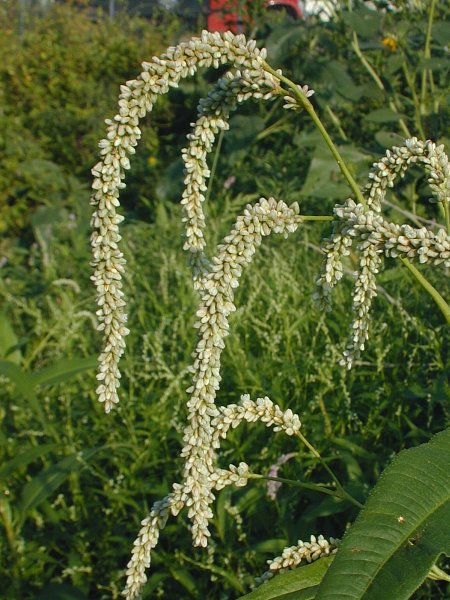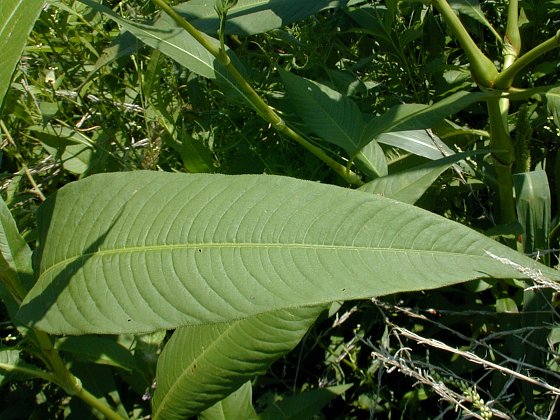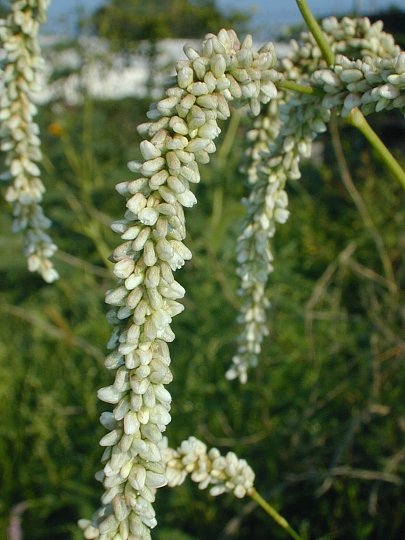Description: This annual plant is about 2½–4' tall, branching occasionally. The stems are light green, terete, hairless, and somewhat swollen at the petiole bases. The alternate leaves are up to 8" long and 2" across; they are medium to dark green, lanceolate, glabrous or slightly pubescent, and their margins are smooth. At the petiole bases, there are membranous sheaths (ocreae) that wrap around the stems. These sheaths often have longitudinal ribs, but they lack bristles along their upper margins. With age, the sheaths gradually turn brown and peel away. The upper stems terminate in spike-like racemes of flowers. These racemes are about 2-8" long, and they droop conspicuously downward. The small flowers are densely crowded together along the length of each raceme.

Each flower is about 1/8" (3 mm.) long,
consisting of 5 tepals and the reproductive organs. These tepals are
usually white or
greenish white; less often they are light
pink. Because the flowers don't open fully, the inner tepals
can be difficult to observe. The flowers have inconspicuous pedicels
(less than 1 mm. in length). The blooming period occurs from mid-summer
to early fall, and lasts about 1½-2 months. There is no noticeable
floral scent. The seeds are dark brown or black, ovoid and bluntly
3-angled in shape, and up to 2 mm. across. The flattened sides of the
seeds are slightly concave and their surfaces are shiny. The root
system is shallow and fibrous. This plant spreads by reseeding
itself, often forming colonies at favorable sites.
Cultivation:
The preference is full or partial sun, wet to moist conditions, and
fertile soil with abundant organic matter. This plant is rather weedy,
and it can be aggressive at disturbed sites. Occasional flooding is
tolerated.

Range & Habitat: Pale Smartweed (Persicaria lapathifolia) is a common plant that occurs in most counties of Illinois (see Distribution Map). Apparently, it has not been observed in a few counties in SW Illinois. This plant is considered native by some authorities, while others regard it as an introduction from Europe. It is possible that both North American and European ecotypes occur in Illinois. Habitats include edges of lakes and ponds, marshes, mudflats and gravel bars of rivers, prairie swales, ditches along railroads and roadsides, and moist waste areas. Occasionally, this common plant will occur at a drier site after a major disturbance, but it will decline in abundance over time. Pale Smartweed is more common in degraded wetlands than higher quality sites.

Faunal Associations: The floral nectar attracts Halictid bees, wasps, flies, and occasionally small butterflies. Insects that feed on the foliage and other parts of Pale Smartweed (Persicaria lapathifolia) and other smartweeds (Persicaria spp.) include the Brassy Flea Beetle (Chaetocnema concinna) and other flea beetles, weevils (Tyloderma spp.), plant bugs, stink bugs, aphids, larvae of sawflies (Ametastegia spp.), and grasshoppers (Paroxyna spp.).Among the Lepidoptera, caterpillars of the butterflies, Bronze Coppper (Lycaena hyllus) and Purple Copper (Lycaena helloides), feed on these plants, as do the caterpillars of the Black Wedge-spot (Homophoberia apicosa) and other moths (see the Insect Table for a more complete list of these insect feeders). The seeds of Pale Smartweed and other wetland smartweeds are a popular source of food to several species of ducks, rails, and wetland songbirds (see the Bird Table for a more complete list). Muskrats and White-tailed Deer feed on these plants to a limited extent (Hamerstrom & Blake, 1939; Myers et al., 2004).

Photographic
Location: A roadside ditch at the
edge of Champaign, Illinois. This species is locally common in the area.
Comments:
This is the largest smartweed species in Illinois. It can be
distinguished from other smartweeds (Persicaria spp.)
by the lack of bristles along the upper margins of its leaf sheaths
(ocreae), and by its drooping cylindrical racemes with densely
distributed flowers that are usually white. Other smartweeds
have cylindrical racemes of flowers that are held more or less erect,
or they have drooping racemes with sparsely distributed
flowers. Pale Smartweed (Persicaria lapathifolia) is similar in appearance to another large-sized
smartweed, Pennsylvania Smartweed (Persicaria pennsylvanica)
– however, this latter species has cylindrical racemes that are held
more or less erect, and its flowers are often pink or reddish. Another difference
between these two species is the size of their seeds: Pale Smartweed
has seeds up to 2 mm. across, while Pennsylvania Smartweed has seeds
that are more than 2 mm. across. Another common name for Pale Smartweed
is Heart's Ease, while Polygonum lapathifolium is
a scientific synonym for this species.